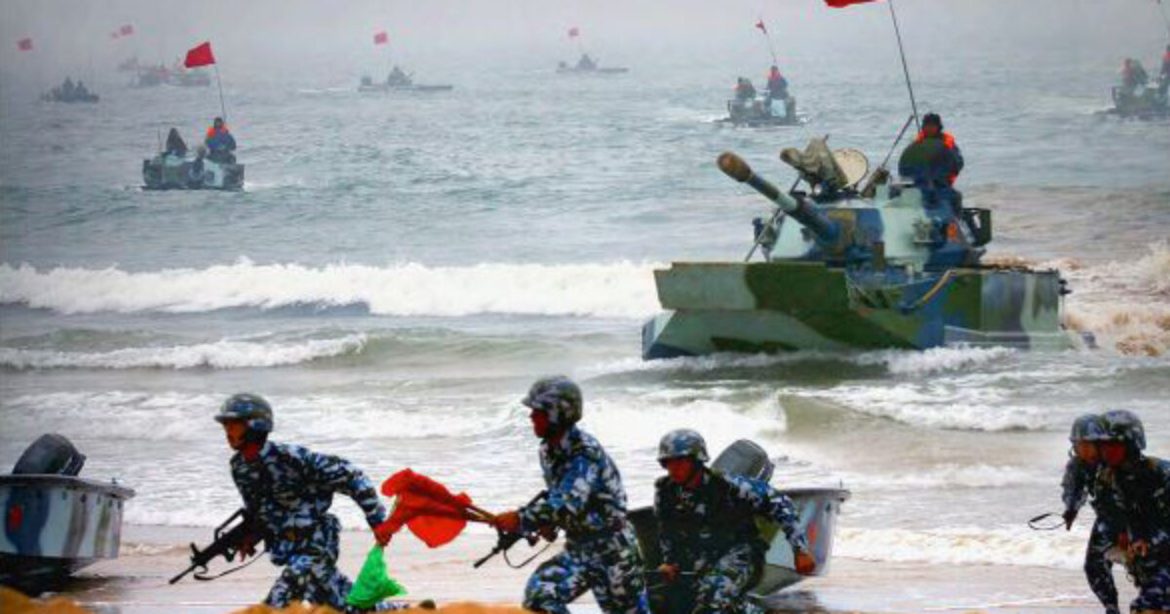

The U.S. Navy conducts freedom of navigation patrols in the Pacific and remains the only force powerful enough to keep global shipping lanes open in the face of Chinese aggression. China claims almost the entire South China Sea, and one key reason it is imperative to prevent China from taking Taiwan is that it would give Beijing control of the Taiwan Strait.
Each year, 44–48% of the world’s container fleet and 88% of the largest ships by tonnage pass through this strait. It is also a vital corridor for energy supplies to Japan and South Korea.
According to a recent U.S. military analysis, China’s People’s Liberation Army (PLA) defense strategy against amphibious assault is a crucial issue for American national security. The concern extends beyond individual operations to how these capabilities fit into China’s broader “anti-access/area-denial” strategy, which is designed to limit U.S. military effectiveness in regional conflicts.
China’s People’s Liberation Army (PLA) sees defense against amphibious assault as part of its broader strategy of active defense. While this posture is strategically disadvantageous, it offers operational benefits in terrain and time, enabling the PLA to weaken enemy forces and create opportunities for counterattack.
Deterrence and anti-access/area-denial (A2/AD) capabilities remain central, with the goal of preventing an assault from ever reaching Chinese shores. Should deterrence fail, the PLA would aim to absorb the initial momentum of an attack, inflict attrition, and then transition back to offensive operations.
This strategy integrates information, cyber, space, and economic actions designed to delegitimize foreign intervention and present China’s response as defensive. The PLA seeks to make any amphibious assault prohibitively costly, employing a layered A2/AD system with naval, air, and missile forces to disrupt and delay adversaries.
The Navy would conduct maneuver defense at sea, supported by coastal missile batteries, surface ships, and even maritime militia to congest sea lanes. The Air Force would attempt to deny adversaries air superiority through aggressive targeting of aircraft and air defense systems, focusing on strikes while enemy forces are still on the ground. Rocket Forces would provide strategic deterrence, targeting airfields and carrier groups with precision missile strikes.
On land, the PLA would avoid static defenses of beachheads and instead position combined arms brigades in depth, using obstacles, mines, and layered defenses to slow and degrade enemy units. Engineers would shape the battlefield with fortifications and kill zones, while joint fires targeted logistics, ammunition, and fuel supplies.
The objective is to preserve combat power early, isolate landing forces, and then counterattack once the adversary has been weakened and disorganized. Rear security would be provided by the People’s Armed Police, guarding against encirclement and airborne insertions.
Ultimately, the counterattack is the decisive phase of PLA defense. By regaining naval and air advantage, or at least targeting enemy logistics and command systems, the PLA hopes to pin assault forces on unfavorable terrain and then destroy them in detail. However, analysts highlight vulnerabilities in this approach.
The PLA’s reliance on A2/AD is risky if these systems are neutralized, while its limited joint operations experience could hinder coordination in a complex, multidomain fight. Naval limitations, particularly in major surface combatants and experience, may also weaken its ability to slow an attacker before landing.
For U.S. forces, confronting this strategy would mean facing an all-domain defense that integrates missiles, electronic warfare, cyber disruption, and contested logistics from mobilization onward. The PLA’s battlefield transparency and surveillance complicate concealment, while its ability to disrupt communications and navigation adds further challenges.
Despite its growing strength, the PLA’s amphibious defense strategy remains vulnerable to adversaries capable of exploiting gaps in technology, joint integration, and naval effectiveness.
For the US, a central focus is Taiwan. The PLA’s expanding amphibious capabilities directly support Beijing’s stated goal of “reunification.” A successful Chinese assault on Taiwan would not only endanger the island’s survival but also compel U.S. involvement under the Taiwan Relations Act. Such an outcome would fundamentally alter the balance of power in the Indo-Pacific.
This threat extends beyond Taiwan itself. China’s amphibious capabilities are aimed at breaking through the “First Island Chain,” the strategic arc running from Japan through Taiwan to the Philippines. If Beijing were able to control this chain, it could project power deep into the Western Pacific while restricting U.S. naval access to key allies and vital trade routes.
The implications for America’s alliance network are profound. U.S. security guarantees to Japan, South Korea, the Philippines, and Australia depend on credible deterrence against Chinese aggression. Enhanced amphibious forces could embolden Beijing to pressure these allies, or at least create doubt about the reliability of U.S. defense commitments, weakening America’s regional influence.
The economic stakes are also immense. Approximately $3.4 trillion in annual trade passes through the South China Sea, much of it vital to both the U.S. and global economies. If China gained control over islands and sea lanes through amphibious operations, freedom of navigation would be at risk, with serious consequences for global supply chains and economic stability.
At the same time, the PLA’s investment in amphibious warfare is part of a broader modernization effort that challenges long-standing U.S. technological and operational advantages. New landing craft, expanded marine forces, and updated doctrines reflect China’s determination to build the capabilities necessary not just for Taiwan, but for wider regional dominance.
The post China’s People’s Liberation Army Defense Strategy Against an Amphibious Assault appeared first on The Gateway Pundit.

